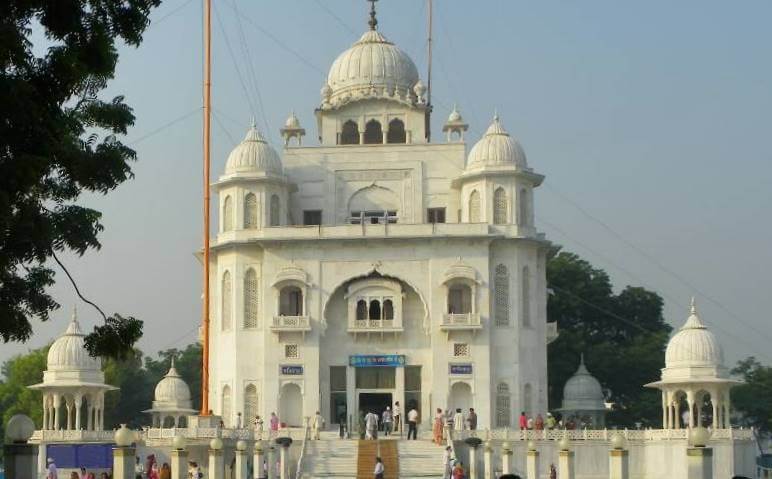
Located in the heart of New Delhi, Gurudwara Rakab Ganj Sahib is one of the historically important Sikh shrines . It stands for the rich legacy of Sikh spirituality, strength and the lasting legacy of Guru Tegh Bahadur Ji, the ninth Guru of the Sikhs.
This Gurudwara is not just a place of worship but symbolizes the faith and commitment of the Sikh community to its principles.
Historical Significance
Guru Tegh Bahadur Ji, the ninth Guru of the Sikhs, is remembered as a champion of human rights and religious freedom. During his time, the Mughal Emperor Aurangzeb had undertaken oppressive measures to impose Islam on non-Muslims.
In response, Guru Tegh Bahadur Ji stood up to protect the religious freedom of the Kashmiri Pandits, who had approached him seeking his guidance and support. For his resistance to religious persecution and unwavering support of the right to religious autonomy, he was arrested and brought to Delhi, where he endured brutal torture. Eventually, on November 11, 1675, he was executed at Chandni Chowk, and his martyrdom marked one of the most critical moments in Sikh history.
Gurdwara Sis Ganj Sahib in Chandni Chowk stands where he was beheaded, and Gurdwara Rakab Ganj Sahib marks the site where his body was respectfully cremated.
Role of Bhai Lakhi Shah Vanjara
Following Guru Tegh Bahadur Ji's martyrdom, the body was left unclaimed as taking it would have risked severe punishment or death. However, Bhai Lakhi Shah Vanjara, a devout Sikh and trader by profession, courageously decided to take the Guru’s body from the execution site.
With great risk, he transported the Guru’s remains to his home, disguised as part of his usual goods. To avoid detection by the authorities, Bhai Lakhi Shah Vanjara set fire to his own house, using the blaze to cremate Guru Tegh Bahadur Ji’s body respectfully. His act of self-sacrifice and bravery is commemorated at the Gurdwara Rakab Ganj Sahib, which is built on the site of this historic cremation.
He used Rakab (shovel) and Ganji (market) to cremate the guru's body and because of his deep devotion, the place was known as Rakab Ganj .
Construction
Gurudwara Rakab Ganj Sahib was officially established in 1783 when the eminent Sikh leader Sardar Baghel Singh laid the foundation stone. The Gurudwara was built exactly where the body of Guru Tegh Bahadur Ji was cremated. It has undergone several renovations and expansions over the years, evolving into the magnificent sanctuary that it is today .
Architectural Beauty
The architecture of Gurudwara Rakab Ganj Sahib is an evidence to Sikh craft and spiritual beauty.
The main prayer hall is decorated with intricate artwork and an impressive marble floor .
Under the central shade rests the Guru Granth Sahib, the Sikh scripture, where devotees gather to listen to sacred hymns and teachings.
The Gurudwara also has a Sarovar (holy tank) which symbolizes purity and spirituality.
Community Kitchen - Langar
One of the special features of Gurudwara Rakab Ganj Sahib, like all gurudwaras, is the Langar. It is a free community kitchen that serves food to all irrespective of caste, creed or social status. This tradition started by Guru Nanak Dev Ji embodies the Sikh principles of equality, selfless service and compassion. Visitors and volunteers participate in the langar, creating bonds of unity and humility.
Cultural & Spiritual Significance
For Sikhs, Gurudwara Rakab Ganj Sahib is not just a physical structure; it is a sacred place that represents their faith and principles. It is a constant reminder of the sacrifices made by Sikh martyrs to protect their religious freedom and justify the values of justice, equality and compassion.
The Gurudwara is a beacon of interfaith harmony that reflects Guru Tegh Bahadur Ji's legacy of upholding religious freedom for all.
People of different faiths are warmly welcomed and emphasize the Sikh philosophy of universal brotherhood and tolerance.
Annual Celebrations
The Gurudwara organizes various religious and cultural events throughout the year. Guru Nanak Dev Ji's birthday, popularly known as Guru Nanak Gurpurab, is celebrated with great warmth .
Moreover, the martyrdom anniversary of Guru Tegh Bahadur Ji is celebrated with respect and devotion.
These celebrations attract thousands of devotees who come to pay their respects, seek spiritual support and share in the warm welcome of the community.
Conclusion
Gurudwara Rakab Ganj Sahib is not a mere brick and mortar structure; it is a shrine that has the essence of Sikhism - sacrifice, devotion and faith.
Its history, architecture and spiritual significance make it an icon for Sikhs and a source of fascination for visitors from different backgrounds.
By honoring its beauty and historical significance, we are reminded of the enduring legacy of Sikhism and the timeless principles it upholds - a legacy that lives on.
Note- We have made every effort to ensure the accuracy and reliability of the information provided. However, this content is intended for informational purposes only and reflects historical and cultural perspectives. DVN does not assume responsibility for any disputes or actions that may arise from the use of this content. If you believe any information is incorrect or misleading, please contact us.